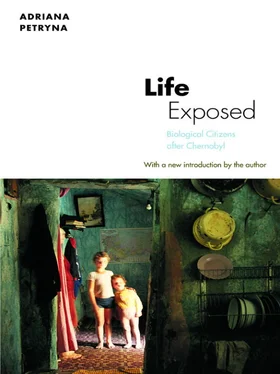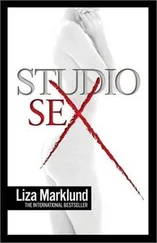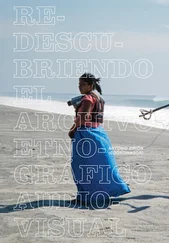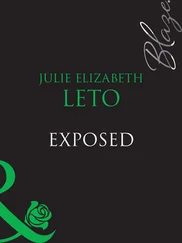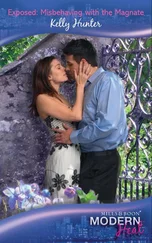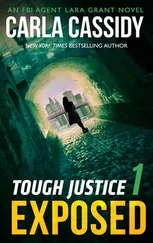The first half of this chapter traced the trajectory of Chernobyl’s ill wind, showing how perception of that wind was reconfigured through a series of informational omissions, technical choices, semiempirical models, approximations, dividing practices, and interventions. Combined, these official practices, with international scientific assistance, produced a picture of a circumscribed biological reality. The biological effects of Chernobyl became inseparable from the political interventions that contained them.
FIGURE 3. Map of 30-km Exclusion Zone, showing levels of cesium-137 contamination as measured in 1988 (adapted from Medvedev 1990)
The Soviet period continued to be marked by controversy over the level at which the radiation threshold dose should be set. By March 1989, the first maps of the spread of contamination were published, and a “Safe Living Concept” was outlined for persons residing in contaminated zones beyond the Exclusion Zone in Belarus, Ukraine, and Russia. Under the concept, the threshold dose for populations was set at 35 rem over an average seventy-year life expectancy. Persons living in areas exceeding this lifetime threshold dose were eligible to receive health and housing benefits elsewhere. Throughout the Soviet period, an image of containment was partially achieved through selective resettlements and territorial delineations of contaminated zones.
The Ukrainian state inherited a technically unresolved and socially volatile Chernobyl aftermath. By 1991, it had declared independence from the former Soviet Union and took on responsibility for the maintenance of the damaged reactor and for ongoing containment strategies. The beginning of the Ukrainian administration of Chernobyl was characterized by a dramatic lowering of the lifetime threshold dose. The Ukrainian version of the Safe Living Concept was part of a first set of laws formulated by the new independent Parliament. “We agreed that over seventy years, a person’s dose could not exceed 0.1 rem per year.” [28] V. D. Lisovyi, member, Parliamentary Commission on Chernobyl, Kyiv, Ukraine, June 1993. According to the current standards developed by the International Commission on Radiological Protection, the maximum permissible annual dose for the general public is 0.5 rem (or 35 rem over an average seventy-year life span). The approximate annual dose from natural background radiation is 0.1 rem (or 7 rem over an average seventy-year life expectancy). Adapted from Medvedev 1990.
The Ukrainians claimed their own expertise and introduced a new standard for biological safety.
These claims and new standards became part of a politics of national autonomy. Their social effects will be considered in more detail in subsequent chapters. In sum, Soviet interventions sought to provide technical solutions to the problem of political disorder. A relatively high threshold dose regulated levels of state intervention and liability and limited the size of populations considered to be at risk. Below this threshold, clinically observable effects were deemed insignificant. In such a technical universe, key ethical questions about the health effects of Chernobyl were evaded. Those questions concern the uncertainties around the fate of the cleanup workers—the so-called bio-robots—who were not airlifted to Moscow and continued to work in the Zone. They also concern the significance of health effects among people who lived in contaminated areas and were resettled, or who continue to live in contaminated areas.
In the remainder of this chapter, I continue to elucidate the values that are both implicit and explicit in technical responses to Chernobyl, this time by turning attention to the mainly American experts who took part in subsequent assessments of the toll of the aftermath. In the post-Chernobyl context and in meetings with Soviet colleagues, radiation safety experts affiliated with the International Atomic Energy Agency made assessments of the health effects of Chernobyl-related radiation exposure, which, among other things, tended to undercut the veracity of local scientific claims of radiation-induced damage. My concern here is not to reiterate the story of their complicity with Soviet attempts to downplay the scale of the disaster but to reexamine the basis of expert authority more generally. Experts promoted their authority, in part, on the basis of their allegedly firm grasp of what constituted proper evidence of Chernobyl-related damage. One goal of their mission was to instruct their Soviet counterparts on how to evaluate the kind of damage that was considered relevant to expert assessment; it was to turn their disaster-fatigued Soviet counterparts into “valid witnesses” of the disaster’s human toll, and to make the witnessing of the uninitiated marginal and invalid (Shapin and Schaffer 1985). I counterpose this expertise with the ways other valid witnesses—namely, basic scientists working in U.S. radiation laboratories, who are less invested in the arts of Chernobyl truth making—think about the human health effects of radiation induction. In this light, I look at scientific constructions of biological risk and safety and situate them in the context of their laboratory production and testing. In the process, we learn about the extent to which ways of monitoring radiation’s health effects are contested at the level of basic science research, and how dependent such research is on the political and economic arenas in which knowledge of radiation risk and safety is brokered.
• • •
The journal Nature published an editorial on the tenth anniversary of Chernobyl urging politicians to make funds available for further studies of the unique scientific and medical experiment afforded by that nuclear accident (“Chernobyl’s Legacy” 1996:653). Chernobyl’s “legacy to science” is knowledge of the impact of radiation on living organisms, and this, according to the editor, should not be lost. Some of the immediate lessons learned, the editorial notes, include the knowledge that bone marrow transplantations for patients with acute radiation sickness are relatively ineffective; that previous calculations of the impact of likely dose exposures were correct (this claim is questionable); and that taking measures to prevent thyroid cancers resulting from radioactive iodine exposure can be effective. Moreover, an alleged absence, to date, of documented cases of leukemia among exposed groups is also consistent with predicted dose-response relationships based on relatively low exposure to cesium in the ground. The editorial calls for continued research on the Chernobyl accident aimed at achieving greater refinement in approaches to nuclear risk management (especially with regard to the massive effort to clean up nuclear facilities in the United States). Supporting arguments are framed in the language of a cost-benefit analysis.
[The extent of the effort] depends critically on the social acceptability of radiation levels that will be left after the clean-up has been completed. If there is a threshold [dose] below which radiation has no long-term biological effect, will much be gained by achieving complete elimination? Conversely, if no threshold [dose] exists, can the cost of eliminating radiation risks entirely be justified by the likely medical benefits if these are, ultimately, insignificantly small? (653)
Such statements elucidate the capitalist social contexts and values that are implicit and explicit in data-production with respect to radiation-contaminated sites. More broadly, they illustrate how interrelated spheres of scientific, social, and economic production are in the area of radiation safety. In later chapters, we will see in Ukraine how the radiation sciences and safety issues (as applied to Chernobyl) are embedded in particular forms of institutional and individual politics of nationhood, market economic policies, and the welfare struggles of post-Soviet citizens. In the United States (as exemplified by the editorial in Nature ), the aims of such sciences are similarly multipurpose. They are to refine knowledge about the impact of radiation on living organisms, offer methods for evaluating epidemiological intervention, and, most important, to develop an empirical database for rationalizing the cost-effectiveness and potential medical benefits of cleanup efforts—for all of which, incidentally, Chernobyl is named a “living laboratory.” [29] Such cost-benefit analyses of existing nuclear sites are becoming globalized as standard practice. They influence local responses and local tolerances for heightened nuclear risk and have played a key role in the negotiation for international funds for cleanup of nuclear sites such as the Chernobyl power plant.
Читать дальше
